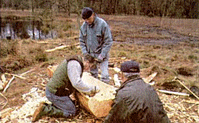The Boat Pesse – Reconstruction
 Due to new discoveries, especially in Denmark, much more is known about prehistoric canoes than in 1955.
Due to new discoveries, especially in Denmark, much more is known about prehistoric canoes than in 1955.
During a visit of the Danish archaeologist, S. Anderson to the Drenthe Museum a few years ago there was the discussion of whether the Pesse boat was indeed a boat. The only way to shed some light on this is an experiment.
Strictly speaking, it should not be necessary to hollow out the log in the prehistoric manner. It would take much less time to perform the task with a chainsaw. It is not so crucial to the sailing ability. Now there is a proper tree at one’s disposal, it would be a missed opportunity to not also include the crafting method as part of the experiment. Therefore, exclusive use of flint tools and deer horns was preferred.
 After the felling of the tree they began shaping the front of the canoe with iron axes (this is the side which when cut with a sharp stone hatchet would have automatically become pointed). Then the bark was removed with oak wedges on a stem.
After the felling of the tree they began shaping the front of the canoe with iron axes (this is the side which when cut with a sharp stone hatchet would have automatically become pointed). Then the bark was removed with oak wedges on a stem.
On the banks of a fen, which must have looked quite the same thousands of years ago – a primitive shipyard was built and a team worked to build a canoe. This was a replica of the famous boat from Pesse, a relic of antiquity which in recent years had much to prove.
 This prehistoric canoe ever, which of course was a bit eaten away by time, and excavated near Pesse, was given the title of World’s Oldest Boat – a predicate which raised doubt later in academic circles. Was it a boat or we are dealing with an ordinary feed trough? There was only one opportunity to discover the truth, and that was to reproduce the canoe and try to accurately demonstrate its sailing capabilities. And so the museum staff went to Assen, Drenthe where the original canoe is kept. They selected a beautiful tree and chopped it into the shape of the original Kano. That happened in prehistoric times – even imitated – as various types of flint axes from the Middle Stone Age.
This prehistoric canoe ever, which of course was a bit eaten away by time, and excavated near Pesse, was given the title of World’s Oldest Boat – a predicate which raised doubt later in academic circles. Was it a boat or we are dealing with an ordinary feed trough? There was only one opportunity to discover the truth, and that was to reproduce the canoe and try to accurately demonstrate its sailing capabilities. And so the museum staff went to Assen, Drenthe where the original canoe is kept. They selected a beautiful tree and chopped it into the shape of the original Kano. That happened in prehistoric times – even imitated – as various types of flint axes from the Middle Stone Age.
* The original photos on this page come from the Drenthe Museum